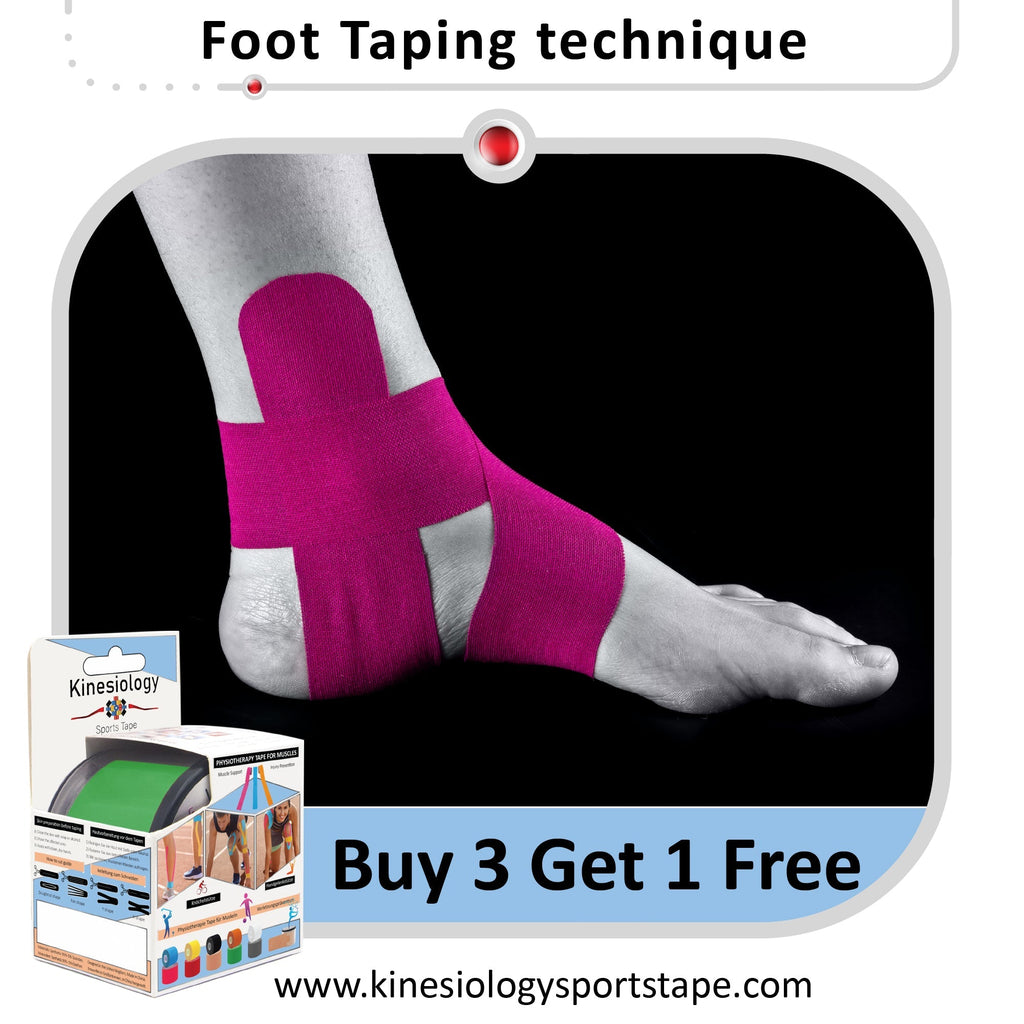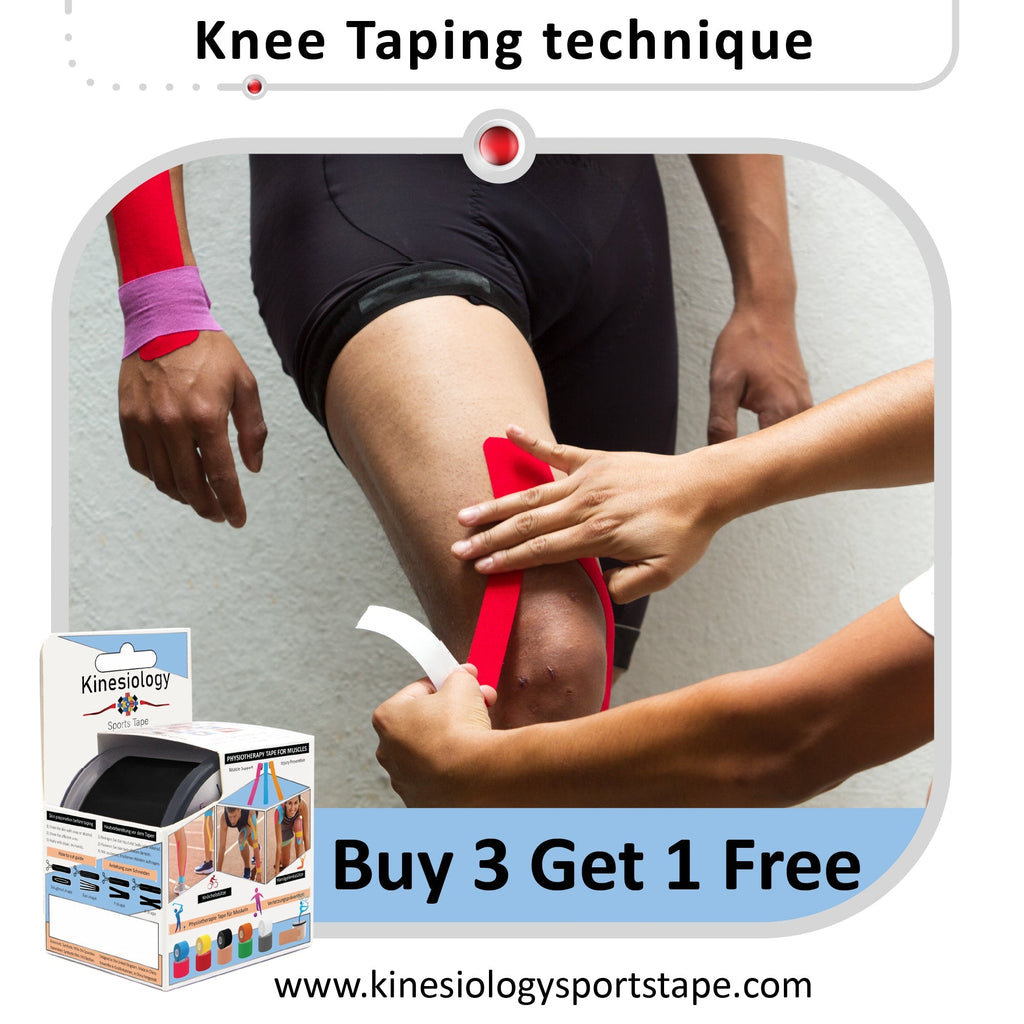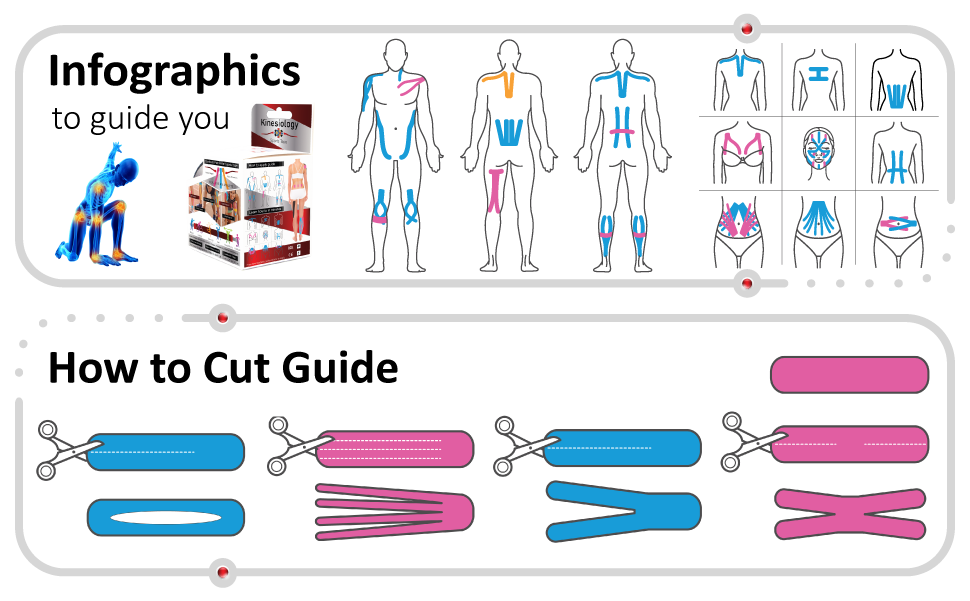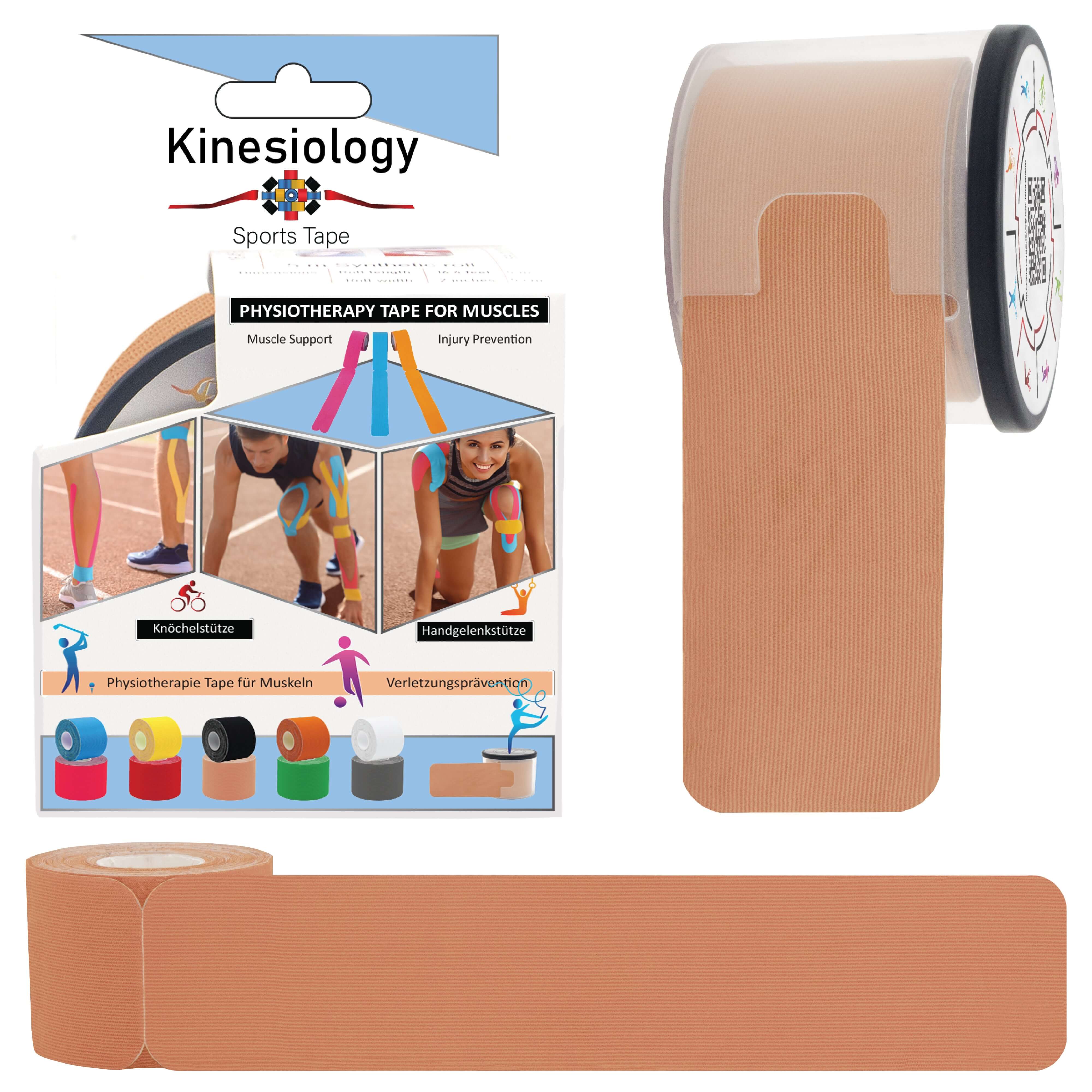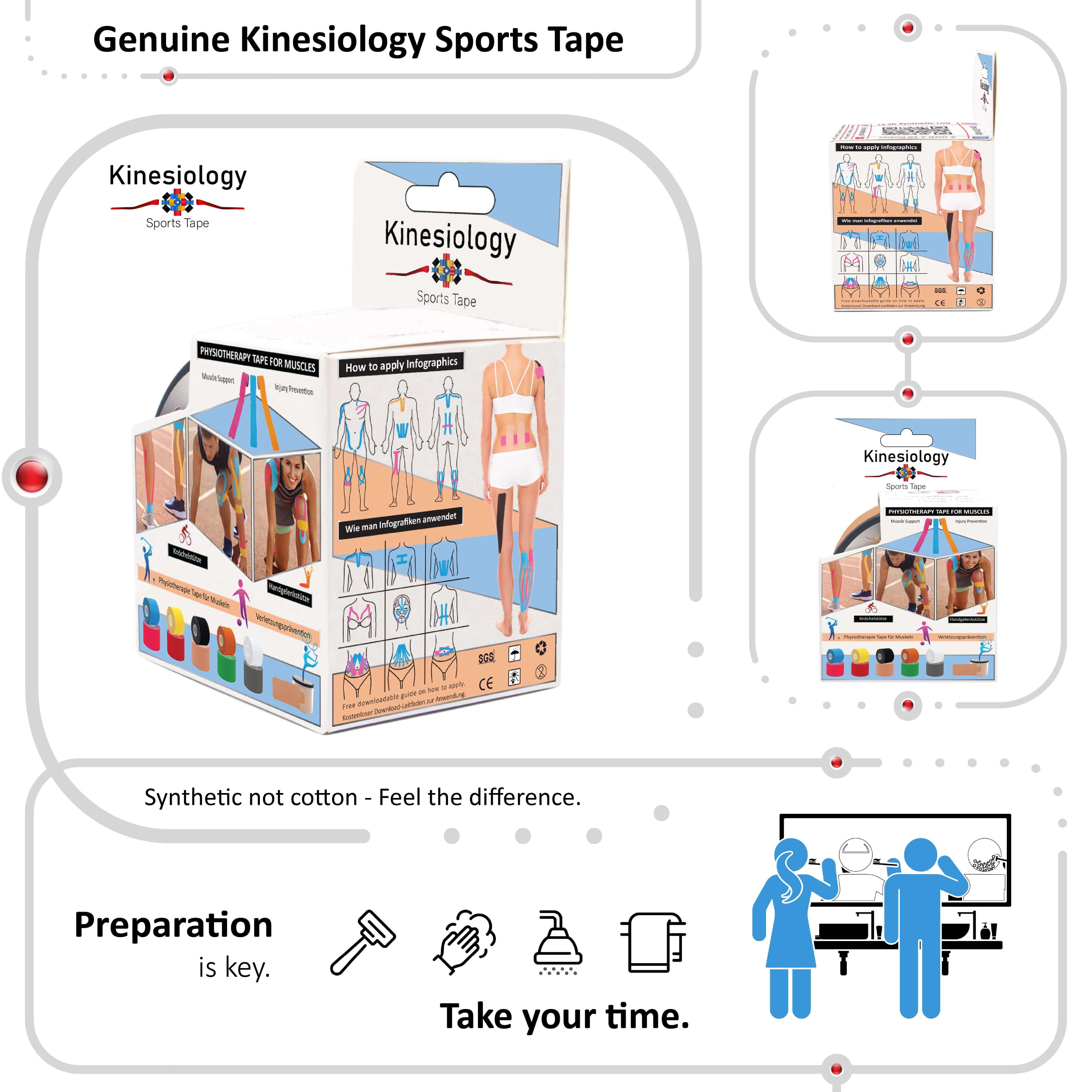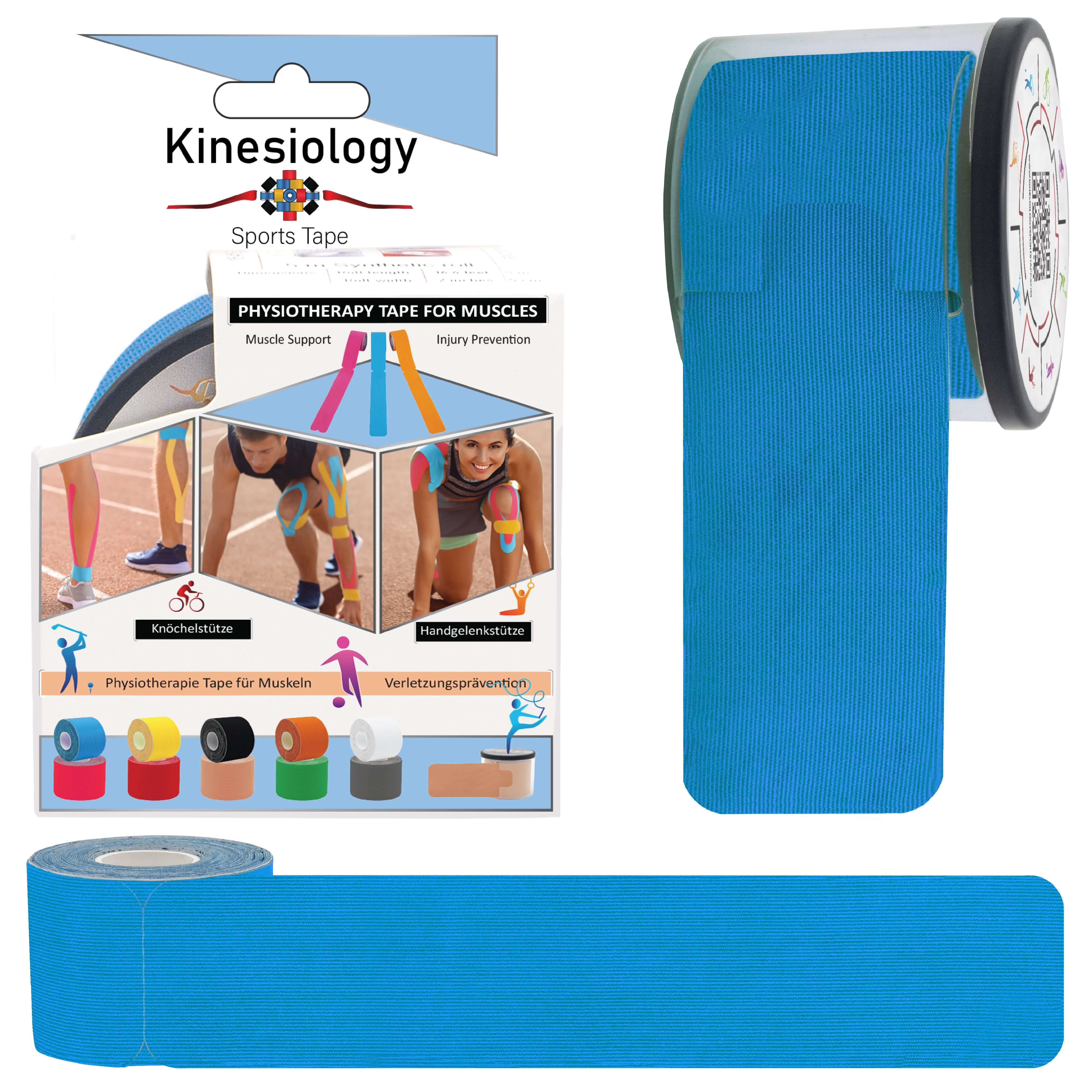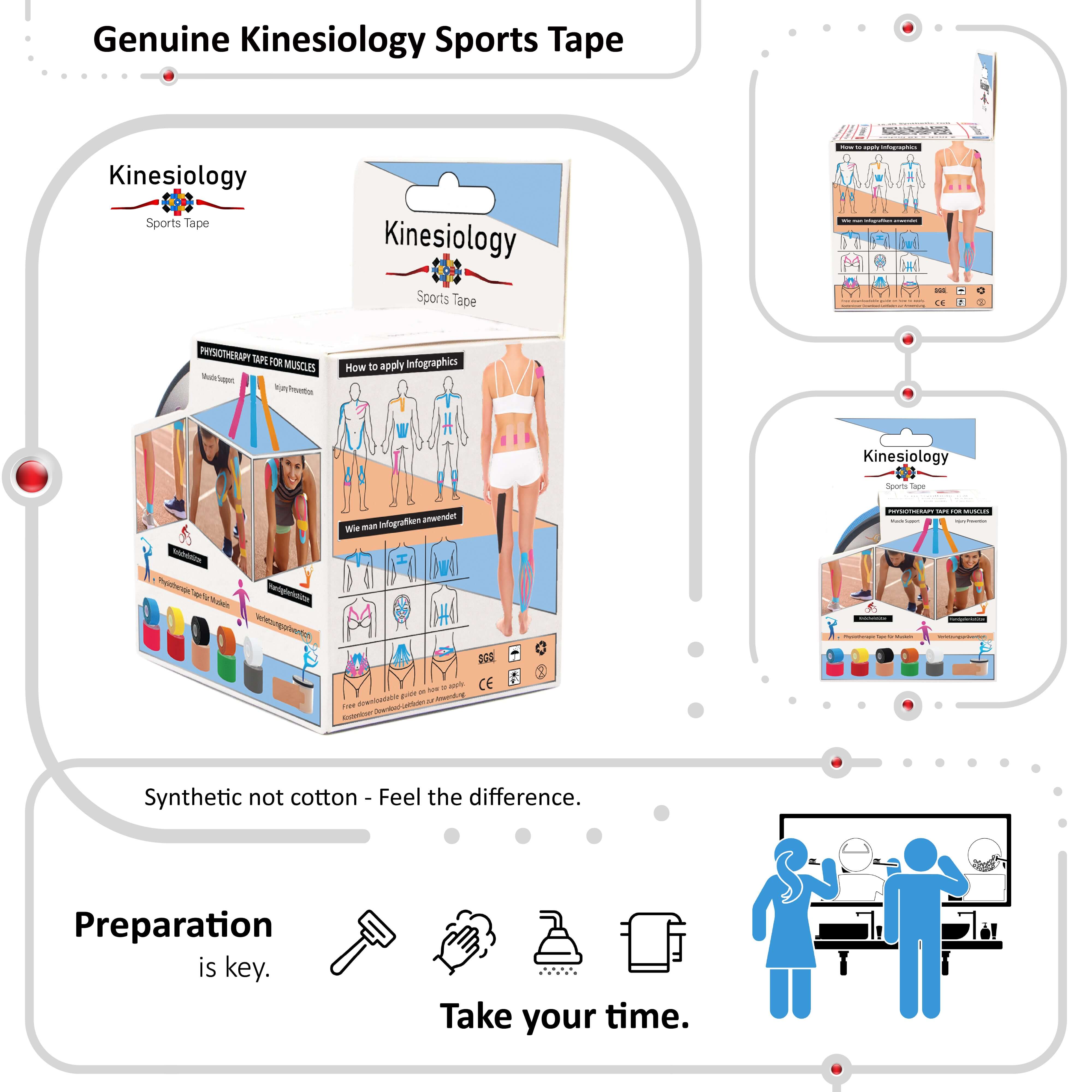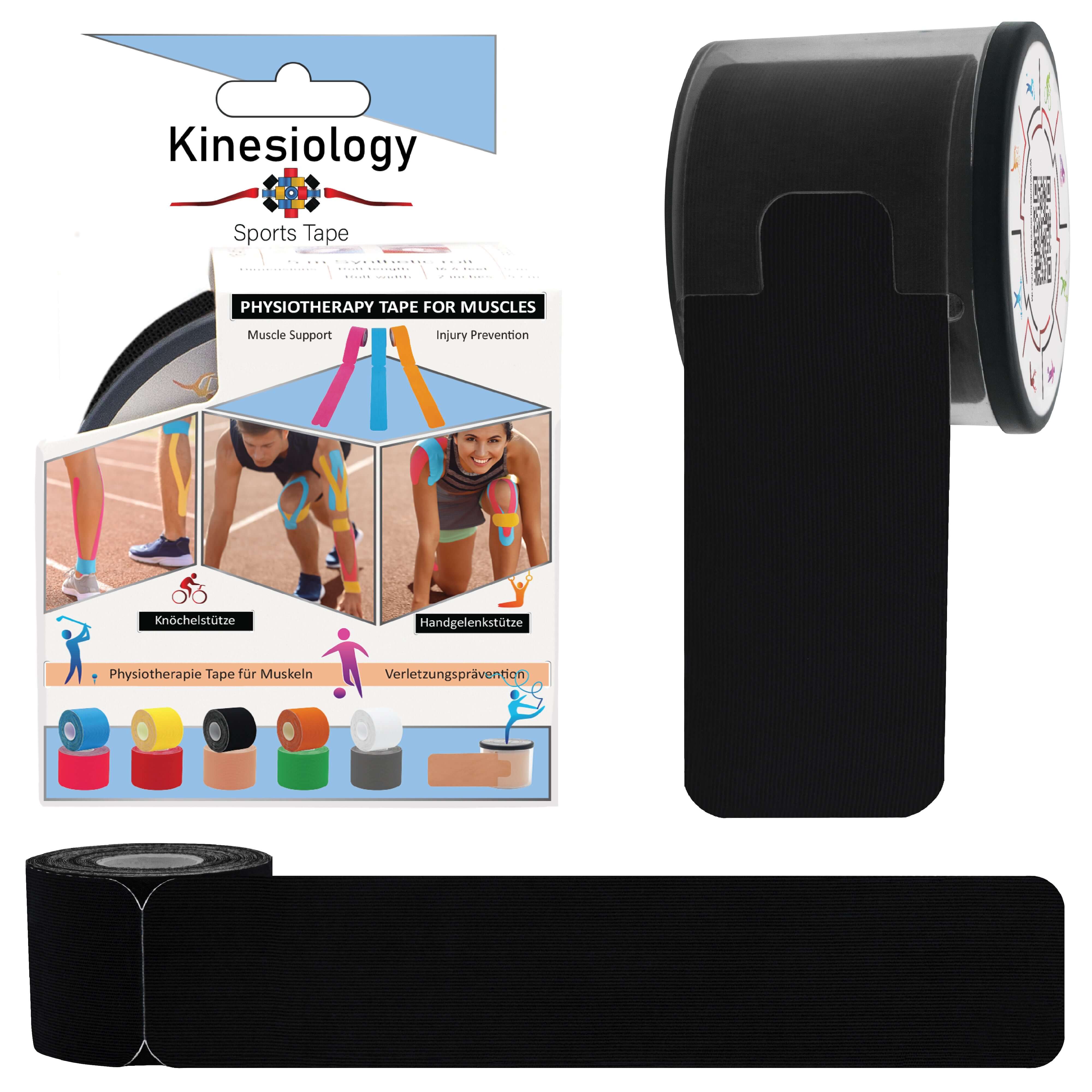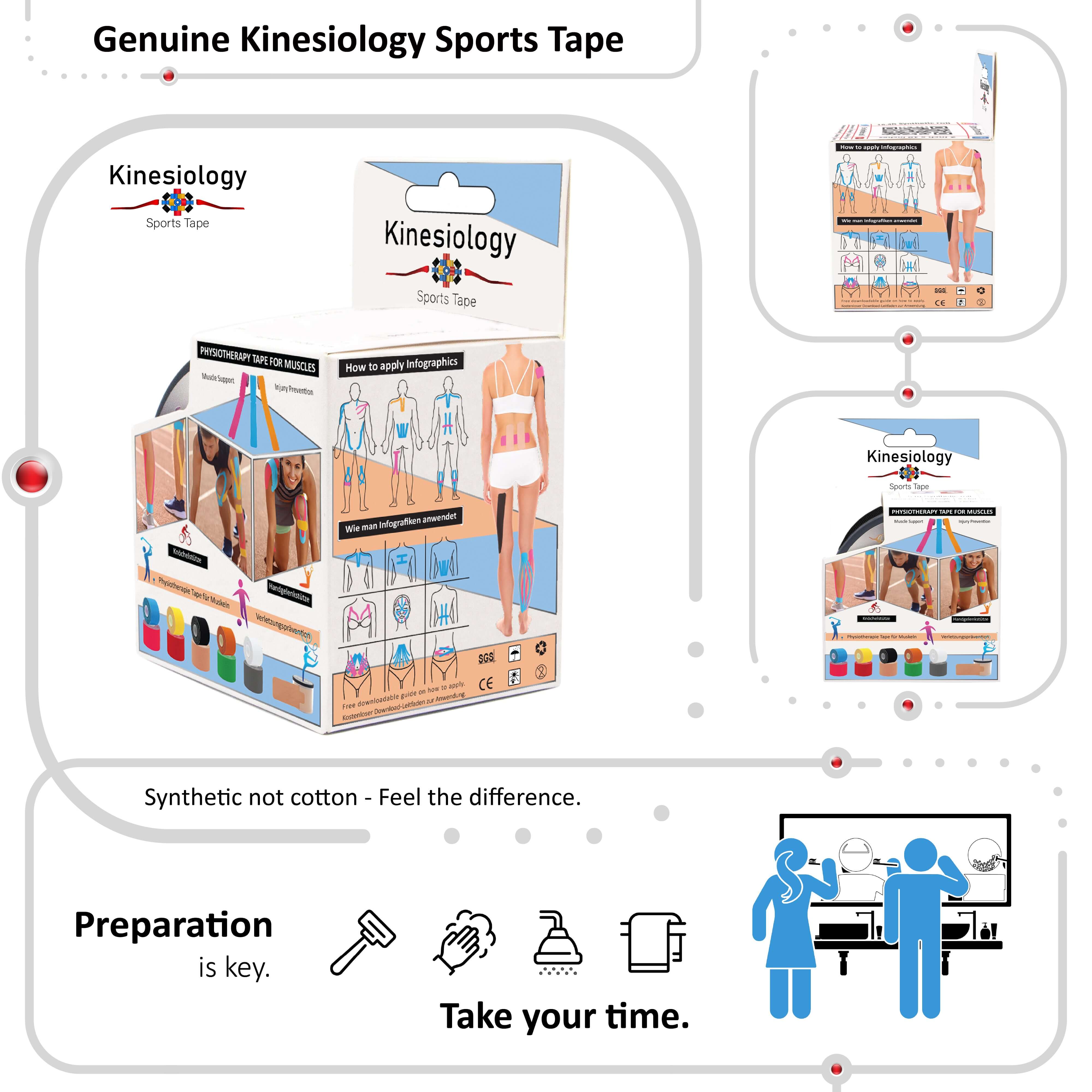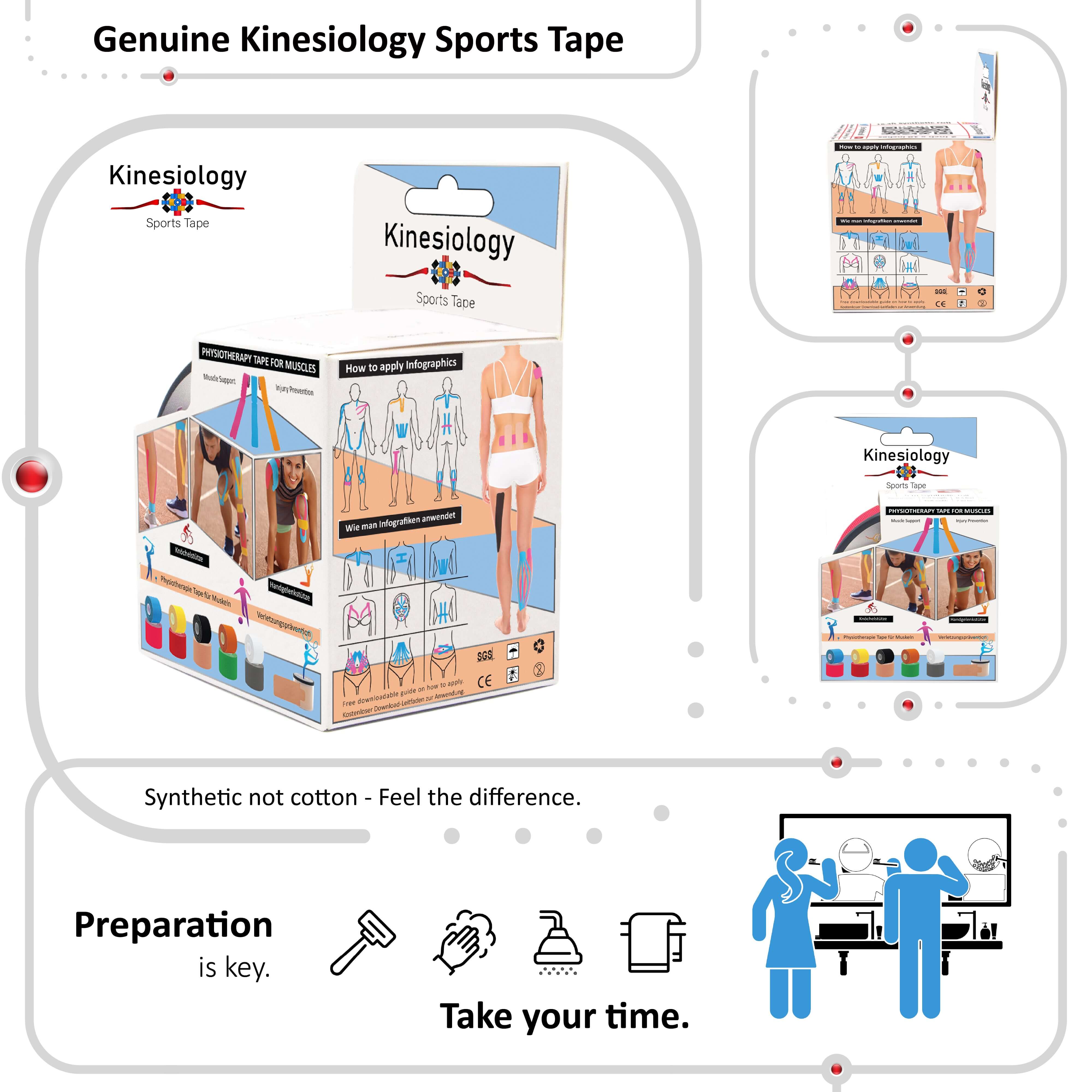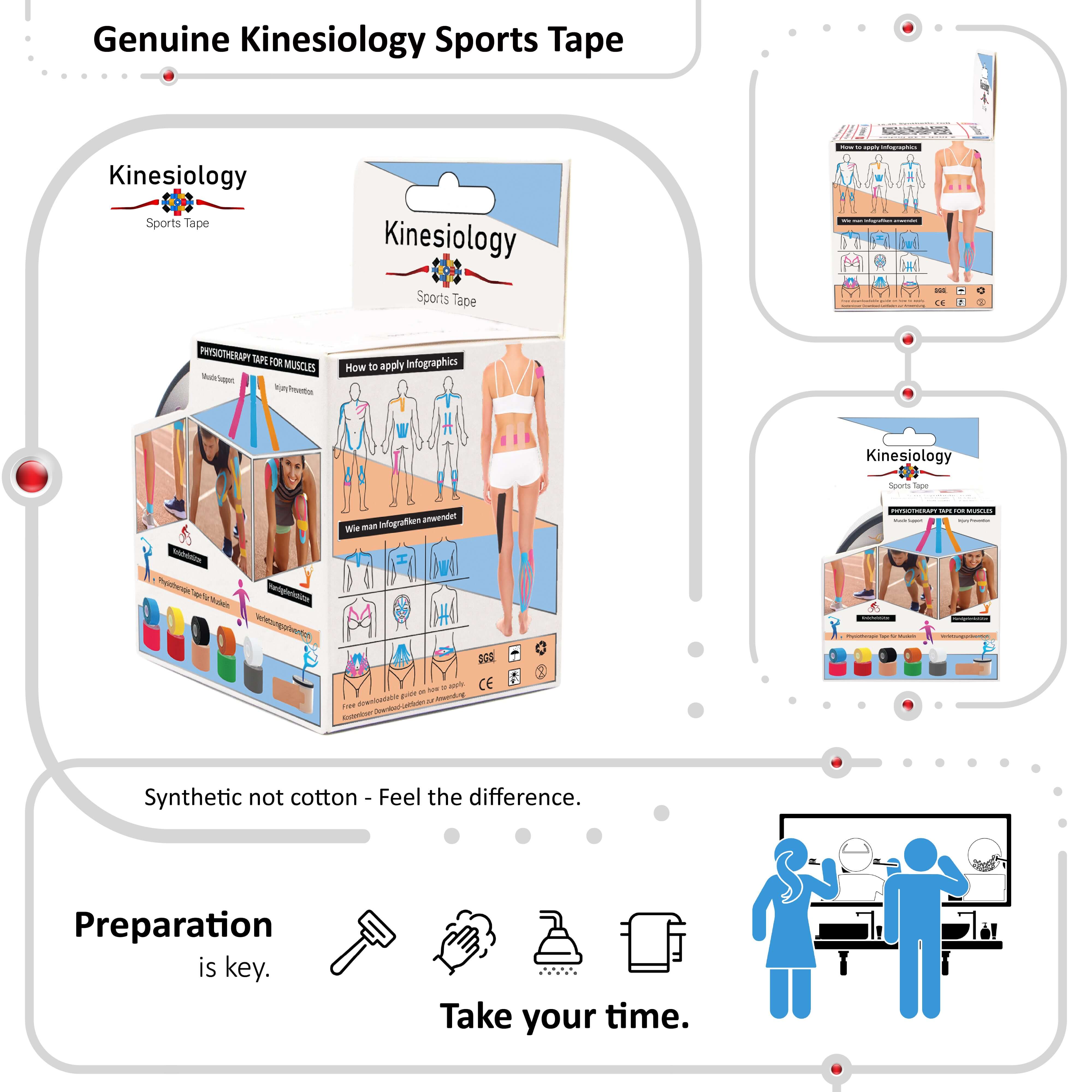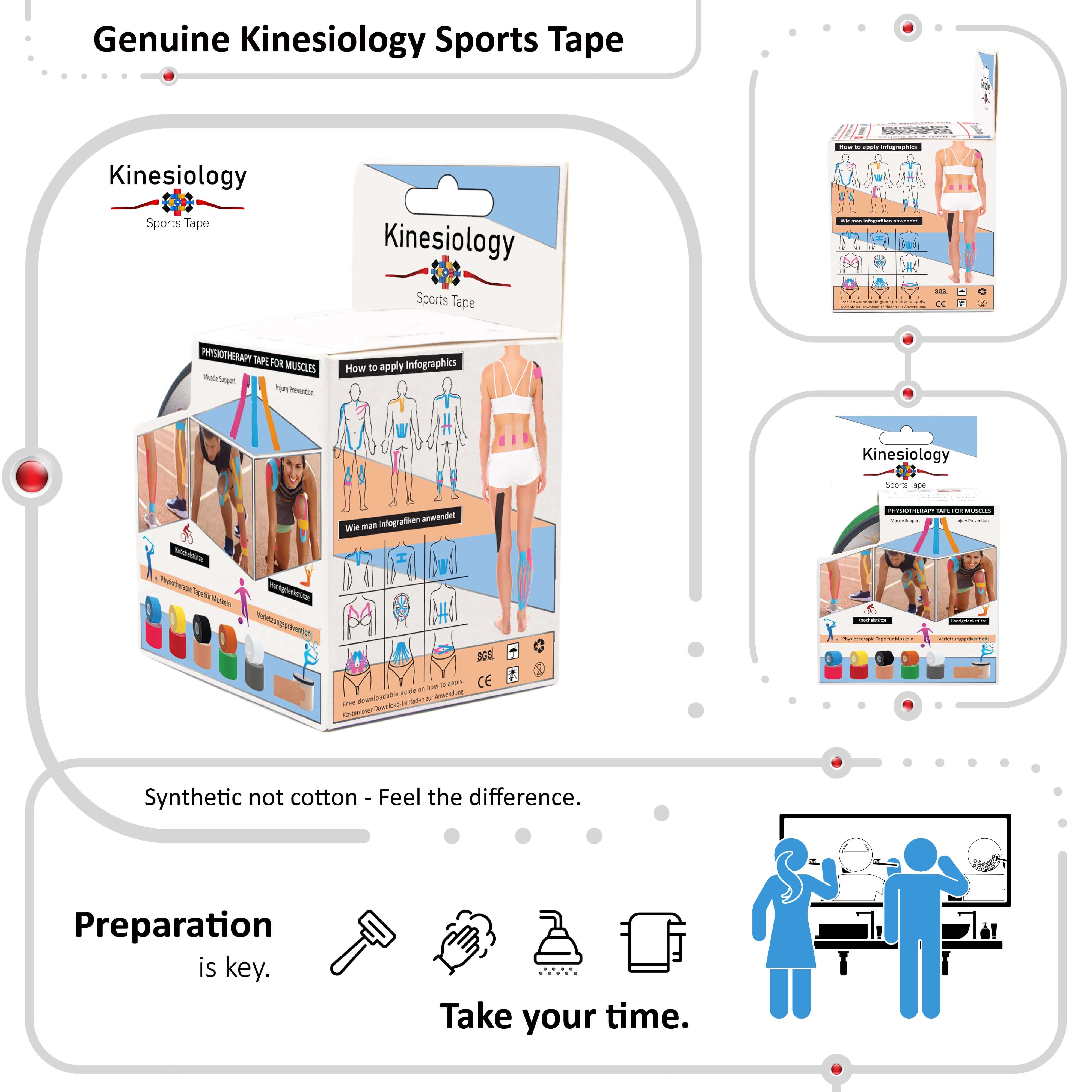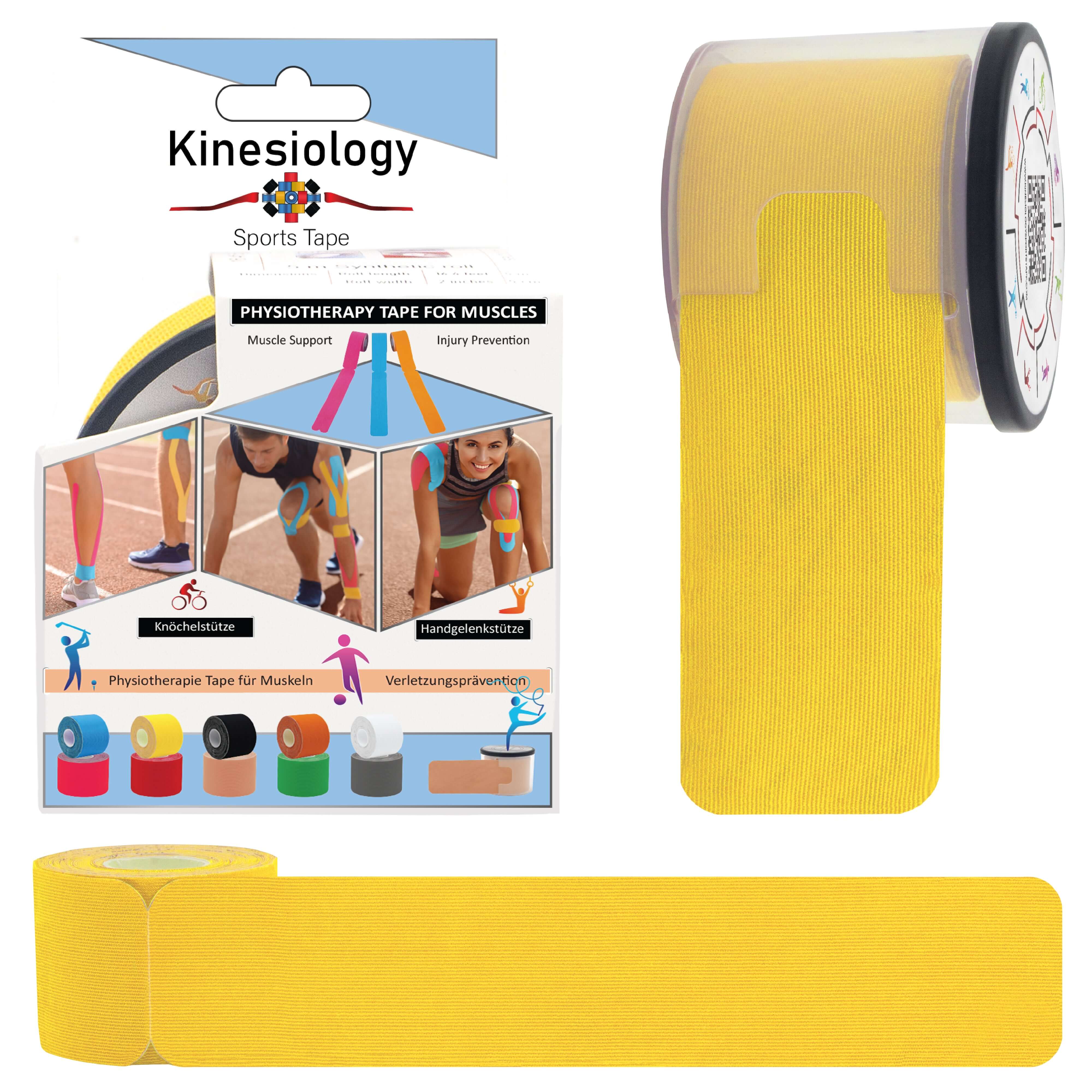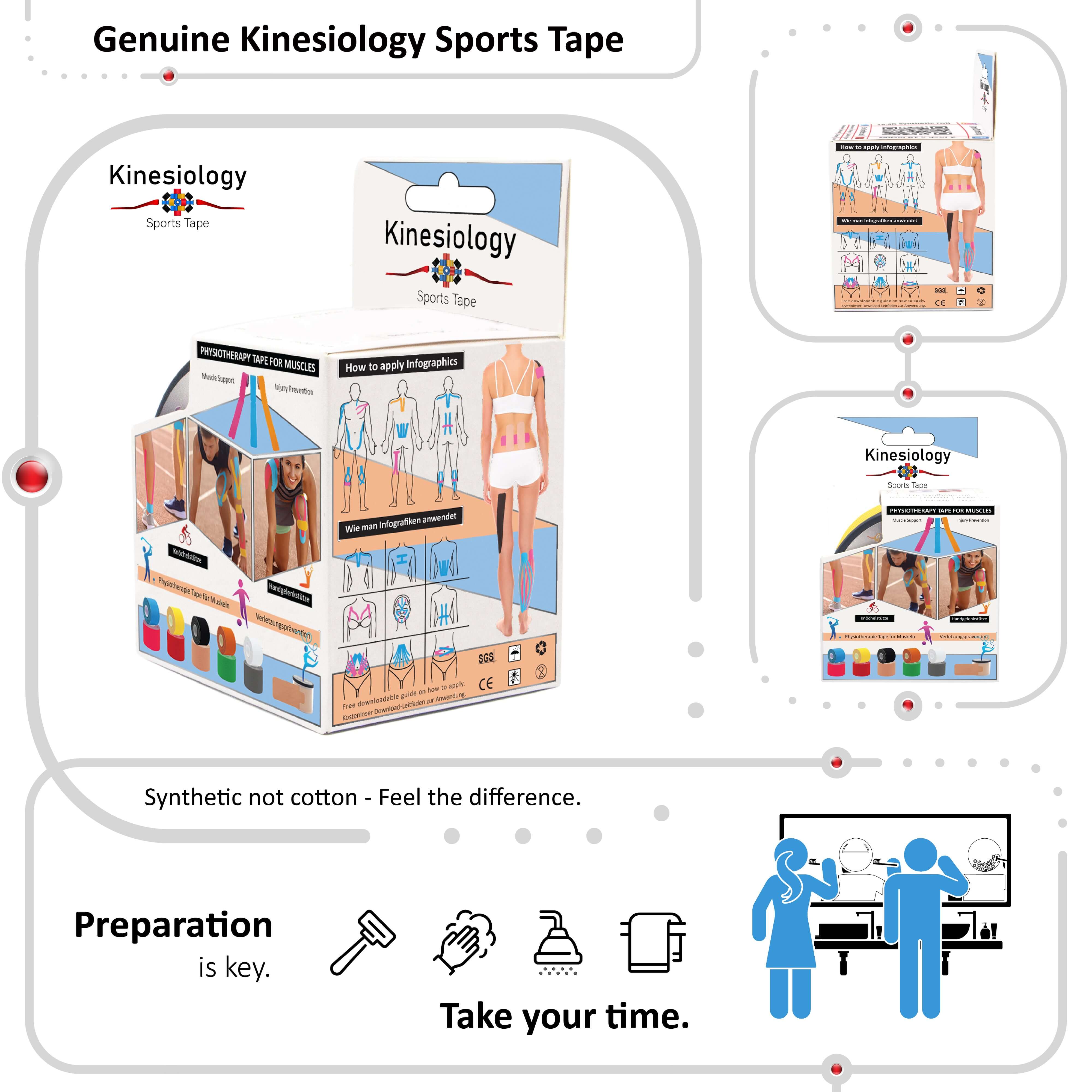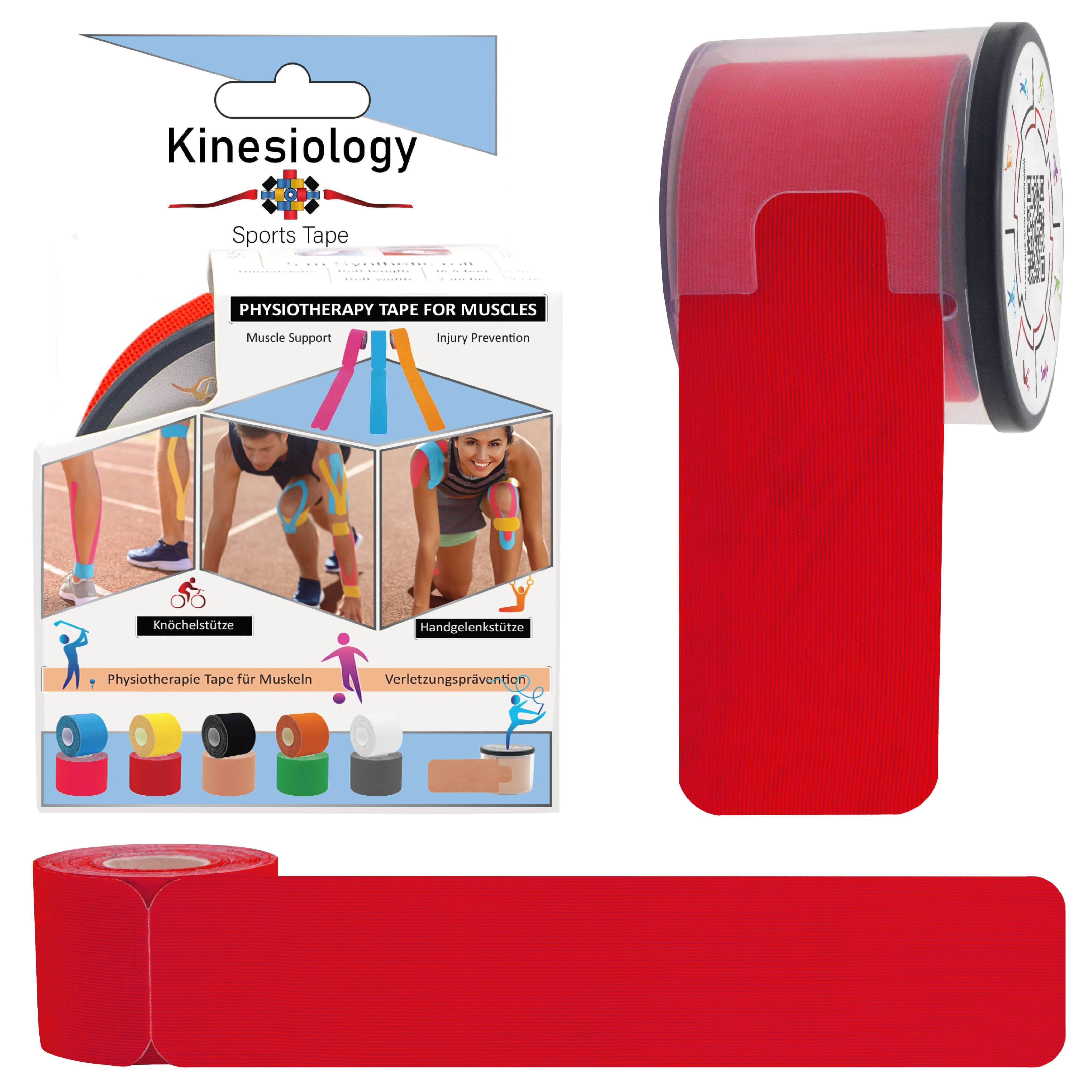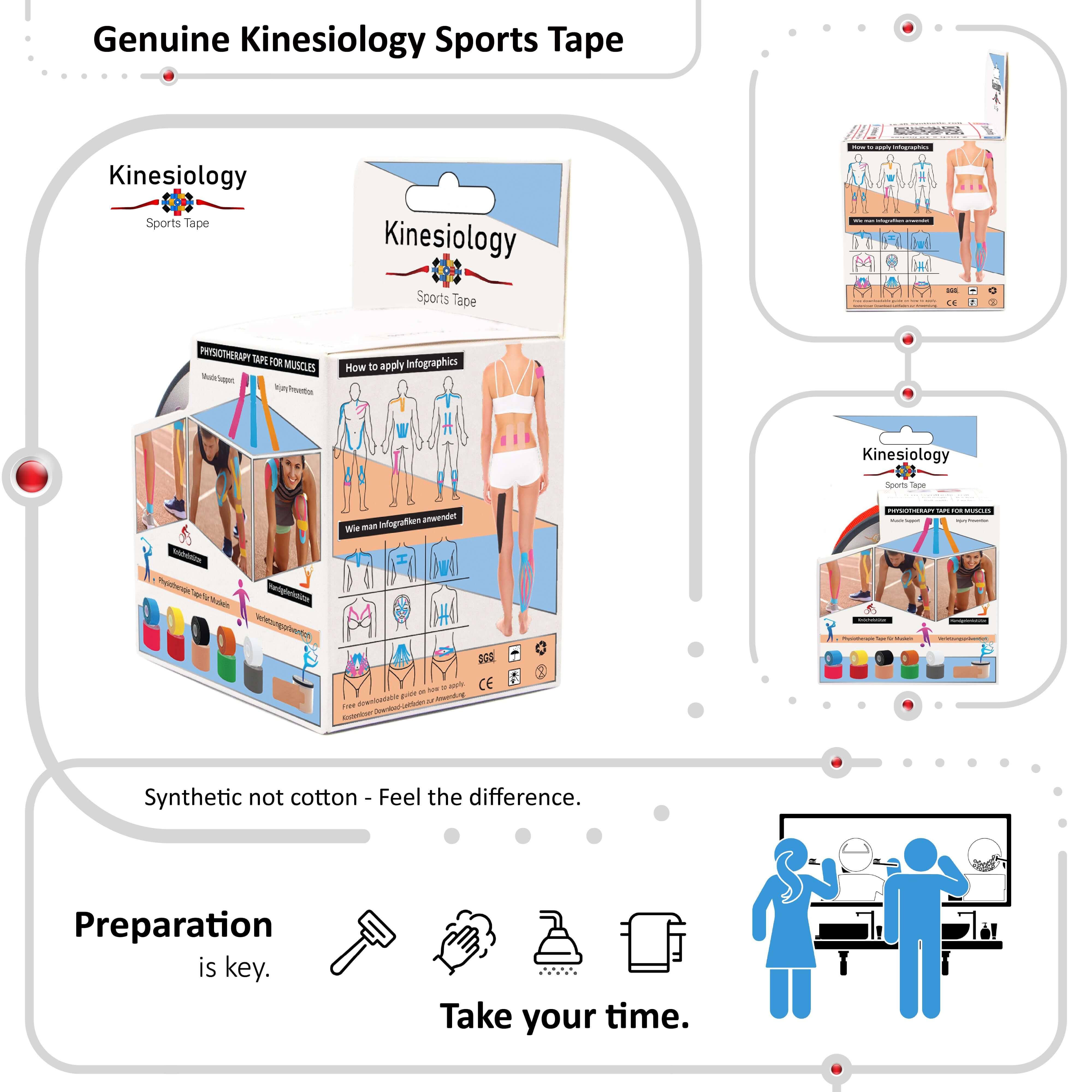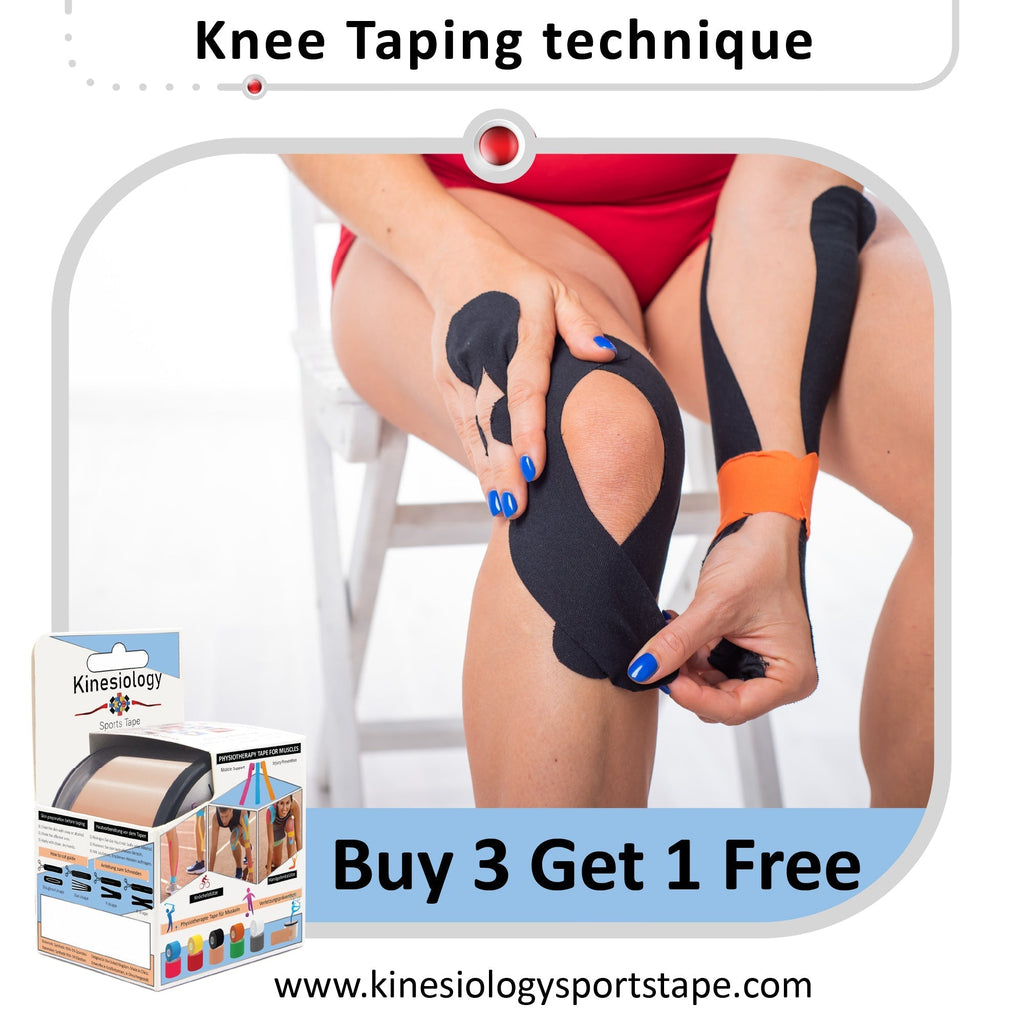
Kinesiology Tape for Knee Pain: Complete Relief Guide for Athletes and Active Individuals

Kinesiology Tape for Knee Pain: Complete Relief Guide for Athletes and Active IndividualsKnee pain affects millions of people worldwide, from weekend warriors to professional athletes, and from young adults to seniors dealing with age-related joint changes [1]. The knee joint, being one of the largest and most complex joints in the human body, is particularly susceptible to injury and overuse conditions due to its role in supporting body weight while allowing for complex movements in multiple planes. Traditional approaches to knee pain management often involve rest, medication, or bulky braces that can restrict movement and interfere with daily activities.Kinesiology tape has emerged as a revolutionary approach to knee pain management, offering a unique combination of support, pain relief, and movement facilitation that sets it apart from conventional treatment methods [2]. Unlike rigid braces or restrictive athletic tape, kinesiology tape works with the body's natural biomechanics to provide therapeutic benefits while allowing full range of motion. This innovative approach has gained widespread acceptance among healthcare professionals, athletes, and active individuals seeking effective, non-invasive solutions for knee pain.The effectiveness of kinesiology tape for knee pain lies in its ability to address multiple aspects of knee dysfunction simultaneously [3]. Through its unique elastic properties and specialized application techniques, kinesiology tape can reduce pain, improve circulation, enhance proprioception, and provide mechanical support without restricting the natural movement patterns essential for knee function. This multi-modal approach makes it particularly valuable for both acute injury management and chronic pain conditions.Understanding how to properly apply kinesiology tape for knee pain requires knowledge of knee anatomy, common pain patterns, and evidence-based application techniques [4]. Different knee conditions require different taping approaches, and the specific pattern, tension, and direction of tape application can significantly influence therapeutic outcomes. Whether dealing with patellofemoral pain syndrome, IT band syndrome, meniscus issues, or general knee instability, proper kinesiology tape application can provide significant relief and functional improvement.This comprehensive guide will explore every aspect of using kinesiology tape for knee pain, from understanding the underlying mechanisms to mastering advanced application techniques for specific conditions. By the end of this guide, you'll have the knowledge and skills necessary to effectively use kinesiology tape as part of a comprehensive approach to knee pain management and injury prevention.Understanding Knee Anatomy and Common Pain CausesThe knee joint represents one of the most sophisticated mechanical structures in the human body, consisting of multiple bones, ligaments, cartilage structures, and muscles that work together to provide stability while allowing complex movement patterns [5]. The primary bones forming the knee joint include the femur (thighbone), tibia (shinbone), and patella (kneecap), which articulate through a complex system of ligaments and are cushioned by specialized cartilage structures called menisci.The four primary ligaments of the knee each serve crucial roles in maintaining joint stability and proper movement patterns [6]. The anterior cruciate ligament (ACL) prevents forward displacement of the tibia relative to the femur and is commonly injured in sports involving cutting and pivoting movements. The posterior cruciate ligament (PCL) prevents backward displacement and is often injured in direct impact situations. The medial collateral ligament (MCL) provides stability against inward forces, while the lateral collateral ligament (LCL) protects against outward forces.The menisci, consisting of the medial and lateral meniscus, serve as shock absorbers and help distribute forces across the knee joint [7]. These C-shaped cartilage structures are particularly vulnerable to injury, especially in combination with ligament injuries or through degenerative changes associated with aging. Meniscus tears can cause pain, swelling, and mechanical symptoms such as catching or locking of the knee joint.Patellofemoral pain syndrome, often referred to as "runner's knee," represents one of the most common knee pain conditions affecting active individuals [8]. This condition involves pain around or behind the kneecap and is often related to improper tracking of the patella during knee movement. Factors contributing to patellofemoral pain include muscle imbalances, particularly weakness in the vastus medialis oblique (VMO) muscle, hip weakness, and biomechanical abnormalities in foot and ankle function.Iliotibial band (IT band) syndrome is another prevalent condition, particularly among runners and cyclists, characterized by pain on the lateral (outside) aspect of the knee [9]. The IT band is a thick band of connective tissue that runs from the hip to the knee and can become tight or inflamed, leading to friction and pain where it crosses the lateral femoral condyle. This condition is often associated with training errors, biomechanical issues, and muscle imbalances in the hip and core.Knee osteoarthritis represents a degenerative condition that affects millions of people, particularly those over 50 years of age [10]. This condition involves the gradual breakdown of cartilage within the knee joint, leading to pain, stiffness, and reduced function. While kinesiology tape cannot reverse the degenerative changes, it can provide significant symptomatic relief and functional improvement for many individuals with this condition.Acute knee injuries, including ligament sprains, meniscus tears, and contusions, present unique challenges for pain management and rehabilitation [11]. The inflammatory response associated with acute injuries can benefit from the circulatory and lymphatic effects of properly applied kinesiology tape, while the mechanical support can help protect healing tissues and facilitate early return to function.Kinesiology Tape Mechanisms for Knee Pain ReliefThe therapeutic effects of kinesiology tape for knee pain operate through multiple physiological mechanisms that work synergistically to provide pain relief and functional improvement [12]. Understanding these mechanisms is crucial for optimizing tape application and achieving the best possible outcomes for different knee conditions.The neurological pain modulation effects of kinesiology tape are based on the gate control theory of pain, which suggests that non-painful sensory input can inhibit the transmission of pain signals to the brain [13]. When properly applied, kinesiology tape provides continuous, gentle stimulation to mechanoreceptors in the skin, which can effectively "close the gate" on pain transmission. This mechanism is particularly effective for chronic pain conditions and can provide immediate relief upon tape application.The mechanical lifting effect created by kinesiology tape's elastic recoil properties can significantly impact tissue pressure and circulation around the knee joint [14]. When the tape is applied with appropriate tension and then allowed to recoil, it creates a lifting force on the skin that can decompress underlying tissues. This decompression can improve lymphatic drainage, reduce swelling, and decrease pressure on pain-sensitive structures around the knee.Proprioceptive enhancement represents another crucial mechanism through which kinesiology tape can benefit knee pain sufferers [15]. The continuous sensory input provided by the tape helps improve awareness of knee position and movement, which can be particularly beneficial for individuals with chronic instability or those recovering from injury. Enhanced proprioception can lead to improved movement patterns, reduced risk of re-injury, and better overall knee function.The biomechanical support provided by kinesiology tape differs significantly from that of rigid braces or athletic tape [16]. Rather than restricting movement, kinesiology tape works to optimize movement patterns by providing selective support to specific structures while allowing full range of motion. This selective support can help correct faulty movement patterns that contribute to knee pain while maintaining the natural biomechanics essential for proper knee function.Muscle facilitation and inhibition effects of kinesiology tape can be particularly valuable for addressing muscle imbalances that contribute to knee pain [17]. By applying tape in specific directions and with appropriate tension, it's possible to either facilitate weak muscles or inhibit overactive muscles. For example, taping to facilitate the VMO muscle can help improve patellar tracking, while inhibiting tight IT band structures can reduce lateral knee pain.The psychological benefits of kinesiology tape should not be overlooked, as the visible presence of tape can provide confidence and reassurance to individuals dealing with knee pain [18]. This psychological support can encourage earlier return to activity and improved compliance with rehabilitation programs, ultimately contributing to better outcomes.Step-by-Step Knee Taping TechniquesProper application of kinesiology tape for knee pain requires careful attention to positioning, tape tension, and application sequence to achieve optimal therapeutic effects [19]. The following techniques represent evidence-based approaches that have been proven effective for various knee pain conditions.The basic knee support technique provides general pain relief and stability for a wide range of knee conditions [20]. Begin by positioning the patient lying supine with the knee flexed to approximately 90 degrees. This position places the quadriceps and patellar tendon in a lengthened position, allowing for optimal tape application. Clean and prepare the skin thoroughly, ensuring it is dry and free from any lotions or oils that could interfere with adhesion.Measure and cut two I-strips of kinesiology tape, each approximately 10-12 inches in length, depending on the size of the individual's leg [21]. The first strip will be applied along the medial (inside) aspect of the knee, while the second strip will be applied along the lateral (outside) aspect. Round the corners of each strip to prevent premature lifting and ensure longer wear time.For the medial strip application, begin by applying the anchor (first 2 inches) without tension approximately 4-5 inches above the knee on the medial thigh [22]. Apply the middle portion of the tape with 25-50% tension, following the natural curve of the medial knee and extending down to the medial aspect of the upper tibia. Finish by applying the final anchor without tension on the medial lower leg, approximately 3-4 inches below the knee joint line.The lateral strip follows a similar pattern but addresses the outside aspect of the knee [23]. Apply the anchor without tension on the lateral thigh, then apply the middle portion with 25-50% tension, following the natural contours of the lateral knee and IT band. The tape should cross over the lateral joint line and finish with an anchor on the lateral lower leg without tension.For patellofemoral pain syndrome, a specialized taping technique focuses on improving patellar tracking and reducing pain around the kneecap [24]. This technique involves creating a "basket weave" pattern around the patella using multiple strips of tape. Begin with the knee in 90 degrees of flexion and apply the first strip horizontally across the top of the patella with light tension. The second strip is applied horizontally across the bottom of the patella, again with light tension.The third and fourth strips are applied vertically, one on each side of the patella, creating a supportive framework around the kneecap [25]. These vertical strips should be applied with slightly more tension (25-40%) to provide gentle compression and support to the patellofemoral joint. The final step involves applying a longer strip that encompasses the entire patellofemoral complex, providing overall support and integration of the individual strips.IT band syndrome requires a specific approach that addresses both the tight IT band and the underlying biomechanical issues [26]. Position the patient in side-lying with the affected leg on top and the knee slightly flexed. Apply the first strip along the length of the IT band, starting from the lateral hip and extending to the lateral knee. This strip should be applied with minimal tension (10-25%) to avoid over-stretching the already tight structure.The second component of IT band taping involves addressing the underlying hip weakness that often contributes to this condition [27]. Apply a strip from the greater trochanter (hip bone prominence) across the lateral thigh muscles with moderate tension (25-40%). This strip helps facilitate the hip abductor muscles, which play a crucial role in controlling knee alignment during functional activities.Advanced Knee Taping ApplicationsAdvanced kinesiology taping techniques for knee pain involve more complex patterns and specialized applications designed to address specific conditions or provide enhanced support for high-level activities [28]. These techniques require greater skill and understanding of knee biomechanics but can provide superior results for challenging cases.The McConnell-inspired patellar taping technique represents an advanced approach to managing patellofemoral pain that combines the benefits of traditional McConnell taping with the advantages of kinesiology tape [29]. This technique involves applying multiple strips in specific directions to correct patellar maltracking and reduce pain. The first strip is applied to correct lateral patellar tilt by pulling the patella medially, while subsequent strips address other components of patellar malalignment.For post-surgical knee support, specialized techniques must account for incision sites, swelling patterns, and the specific surgical procedure performed [30]. Lymphatic drainage techniques using fan cuts can be particularly beneficial for managing post-surgical swelling, while gentle support strips can provide comfort and confidence during early mobilization. Care must be taken to avoid placing tape directly over incision sites until they are fully healed.Meniscus support taping involves techniques designed to provide compression and support to the joint line while allowing for normal knee movement [31]. This approach typically involves applying strips that cross the joint line at specific angles to provide targeted support to the meniscal structures. The tape tension and direction must be carefully calibrated to provide support without restricting the normal sliding and gliding movements of the menisci.Sport-specific taping modifications account for the unique demands of different athletic activities [32]. For example, basketball players may require additional lateral support to address the cutting and pivoting demands of their sport, while runners may benefit from techniques that address the repetitive loading patterns associated with distance running. These modifications often involve combining multiple basic techniques or adjusting tape tension and direction to match sport-specific movement patterns.Combination taping techniques involve using multiple different tape applications simultaneously to address complex knee conditions [33]. For example, an individual with both patellofemoral pain and IT band syndrome may benefit from combining patellar support techniques with IT band management strategies. These combination approaches require careful planning to ensure that the different tape applications work synergistically rather than interfering with each other.Troubleshooting and Safety ConsiderationsEven with proper technique, challenges can arise when using kinesiology tape for knee pain, and understanding how to identify and address these issues is crucial for achieving optimal outcomes [34]. Common problems include inadequate pain relief, skin irritation, tape failure, and unexpected increases in pain or discomfort.Inadequate pain relief may indicate problems with tape selection, application technique, or unrealistic expectations about what kinesiology tape can achieve [35]. If initial applications don't provide the expected relief, consider modifying the tape tension, direction, or pattern. Sometimes a different taping technique altogether may be more appropriate for the specific condition being treated. It's important to remember that kinesiology tape works best as part of a comprehensive treatment approach that may include exercise, manual therapy, and other interventions.Skin irritation can occur even with proper application and may be related to individual sensitivity, excessive tape tension, or prolonged wear time [36]. If irritation develops, remove the tape immediately and assess the cause. Future applications may require hypoallergenic tape, reduced tension, or shorter wear times. Some individuals may benefit from using a skin protectant spray before tape application to reduce the risk of irritation.Tape failure during wear is often related to inadequate skin preparation, environmental factors, or improper application technique [37]. If tape consistently fails in certain areas, review your preparation process and consider factors such as hair removal, skin cleaning, and environmental conditions. Sometimes using a skin adherent spray can improve initial adhesion and extend wear time.Contraindications for knee taping include open wounds, active infections, severe swelling, or suspected fractures [38]. Individuals with certain medical conditions, such as diabetes with poor circulation or those taking blood-thinning medications, should consult with healthcare professionals before using kinesiology tape. Never apply tape over areas of compromised skin integrity or suspected serious injury.Proper removal technique is essential for maintaining skin health and preventing damage [39]. Remove tape slowly and carefully, supporting the skin with your free hand. If the tape is difficult to remove, use oil or adhesive remover to help loosen the adhesive. Never rip tape off quickly, as this can damage the skin and create negative associations with taping.Frequently Asked Questions About Kinesiology Tape for Knee PainQ: How long should I wear kinesiology tape on my knee?A: Kinesiology tape can typically be worn on the knee for 3-7 days, depending on your activity level, skin sensitivity, and the specific condition being treated. Most people find that 3-5 days provides optimal benefits while minimizing the risk of skin irritation. If you're very active or the knee area gets wet frequently, you may need to change the tape more often [40].Q: Can I exercise immediately after applying kinesiology tape to my knee?A: Yes, one of the main advantages of kinesiology tape is that it allows for immediate return to activity. However, it's recommended to wait 30-60 minutes after application to allow the adhesive to fully activate. Start with lighter activities and gradually increase intensity to ensure the tape remains secure and provides the intended support [41].Q: Will kinesiology tape cure my knee pain permanently?A: Kinesiology tape is a supportive treatment that can provide significant pain relief and functional improvement, but it's not typically a permanent cure for underlying knee problems. It works best as part of a comprehensive treatment approach that may include exercise therapy, manual therapy, and addressing underlying biomechanical issues. The tape can be an excellent tool for managing symptoms while working on long-term solutions [42].Q: How do I know if I'm applying the kinesiology tape correctly?A: Properly applied kinesiology tape should feel comfortable and supportive without being restrictive. You should notice some degree of pain relief or improved function within the first few hours of application. The tape should stay securely attached without lifting at the edges. If you experience increased pain, skin irritation, or the tape fails quickly, the application may need adjustment [43].Q: Can kinesiology tape help with arthritis knee pain?A: Yes, kinesiology tape can be beneficial for managing arthritis-related knee pain. The tape's pain-modulating effects, combined with its ability to improve circulation and provide gentle support, can help reduce pain and stiffness associated with knee arthritis. However, it's important to have realistic expectations and use taping as part of a comprehensive arthritis management plan [44].Q: Is it safe to sleep with kinesiology tape on my knee?A: Generally, it's safe to sleep with properly applied kinesiology tape on your knee. The tape is designed to be worn continuously for several days. However, if you experience any discomfort, increased swelling, or circulation problems during the night, remove the tape immediately. Some people prefer to apply fresh tape in the morning rather than sleeping with it on [45].Q: Can I shower or swim with kinesiology tape on my knee?A: Yes, quality kinesiology tape is water-resistant and designed to withstand showering, swimming, and sweating. After getting wet, gently pat the tape dry with a towel rather than rubbing vigorously. The tape may take longer to dry completely, but this shouldn't affect its adhesion or effectiveness [46].Q: What's the difference between kinesiology tape and a knee brace?A: Kinesiology tape provides support while allowing full range of motion and can be worn for several days continuously. Knee braces typically provide more rigid support but can be bulky and may restrict movement. Kinesiology tape is also more discreet under clothing and can provide neurological benefits that braces cannot. The choice between them depends on your specific needs and the severity of your condition [47].Q: Can children use kinesiology tape for knee pain?A: Kinesiology tape can be safe for children when applied properly, but extra care should be taken due to their more sensitive skin. Use gentler tension, shorter wear times, and monitor closely for any signs of irritation. Always consult with a pediatric healthcare provider before using kinesiology tape on children, especially for ongoing knee problems [48].Q: How often should I replace the kinesiology tape on my knee?A: Replace kinesiology tape when it begins to lose adhesion, shows signs of wear, or after 5-7 days maximum. If you're very active or the tape gets wet frequently, you may need to replace it every 2-3 days. It's also good practice to give your skin a break between applications, especially if you've been wearing tape continuously for several days [49].Q: Can I use kinesiology tape for prevention of knee injuries?A: Yes, kinesiology tape can be used preventively, especially if you have a history of knee problems or participate in high-risk activities. Preventive taping can help improve proprioception, support proper movement patterns, and provide confidence during activity. However, it shouldn't replace proper warm-up, conditioning, and technique training for injury prevention [50].Q: What should I do if kinesiology tape makes my knee pain worse?A: If kinesiology tape increases your knee pain, remove it immediately and assess the application. The tape may have been applied with too much tension, in the wrong direction, or you may have an underlying condition that requires medical attention. If pain persists after tape removal, consult with a healthcare professional. Sometimes a different taping technique or approach may be more appropriate [51].References[1] https://www.healthline.com/health/knee-pain
[2] https://www.kttape.com/blogs/how-to-apply/full-knee-support
[3] https://www.hss.edu/health-library/move-better/kinesiology-tape
[4] https://www.physio-pedia.com/Kinesio_Taping
[5] https://www.mayoclinic.org/diseases-conditions/knee-pain/symptoms-causes/syc-20350849
[6] https://www.orthoinfo.aaos.org/en/diseases--conditions/common-knee-injuries/
[7] https://www.webmd.com/pain-management/knee-pain/meniscus-tears-symptoms-causes-treatments
[8] https://www.mayoclinic.org/diseases-conditions/patellofemoral-pain-syndrome/symptoms-causes/syc-20350792
[9] https://www.healthline.com/health/fitness/it-band-syndrome
[10] https://www.arthritis.org/diseases/osteoarthritis
[11] https://www.verywellhealth.com/knee-injuries-2696146
[12] https://pmc.ncbi.nlm.nih.gov/articles/PMC8169012/
[13] https://www.verywellhealth.com/kinesiology-tape-in-physical-therapy-2696435
[14] https://www.performancehealth.com/articles/kinesiology-tape-101-everything-you-need-to-know
[15] https://www.ncbi.nlm.nih.gov/pmc/articles/PMC4868206/
[16] https://www.therabandktape.com/videos/applications.html
[17] https://pmc.ncbi.nlm.nih.gov/articles/PMC7349891/
[18] https://www.nuhs.edu/how-the-benefits-of-kinesio-taping-apply-to-more-than-just-athletes/
[19] https://www.thysol.us/how-to-tape/knee-pain/
[20] https://www.youtube.com/watch?v=5KwiWSRhcqA
[21] https://www.healthline.com/health/how-to-tape-a-knee
[22] https://sporttape.co.uk/blogs/news/can-kinesiology-tape-relieve-knee-pain
[23] https://www.tsaog.com/blog/2024/10/21/how-to-tape-a-knee-for-stability-and-pain/
[24] https://www.verywellhealth.com/patellofemoral-pain-syndrome-2696167
[25] https://www.physixgear.com/blogs/sport-and-wellness/kinesiology-tape-vs-athletic-tape-which-one-is-right-for-me
[26] https://www.runnersworld.com/health-injuries/a20791648/how-to-treat-it-band-syndrome/
[27] https://www.healthline.com/health/fitness/it-band-syndrome-exercises
[28] https://www.performancehealthacademy.com/ankle-sprain-kinesiology-taping-technique-tapetuesday.html
[29] https://www.jospt.org/doi/10.2519/jospt.2002.32.4.166
[30] https://www.ncbi.nlm.nih.gov/pmc/articles/PMC4837927/
[31] https://www.webmd.com/pain-management/knee-pain/meniscus-tears-symptoms-causes-treatments
[32] https://www.acsm.org/docs/default-source/files-for-resource-library/knee-injuries-in-athletes.pdf
[33] https://tapegeeks.com/blogs/news/how-to-tape-different-areas-of-the-body
[34] https://www.goodrx.com/well-being/movement-exercise/what-is-kinesiology-tape
[35] https://www.henryford.com/blog/2019/01/kinesiology-tape-help-hype
[36] https://www.verywellhealth.com/treat-your-plantar-fasciitis-with-kinesiology-tape-2696033
[37] https://www.healthandcare.co.uk/blog/ultimate-guide-how-to-apply-kinesiology-tape.html
[38] https://www.orthopaedicsri.com/blog-items/kinesiology-tape-fake-fad-functional/
[39] https://www.shape.com/fitness/tips/how-to-apply-kt-tape-instructions
[40] https://coastalorthopedics.com/blog/benefits-of-kinesio-tape/
[41] https://oaidocs.com/2018/09/14/benefits-of-kinesiology-tape/
[42] https://www.premierhealth.com/your-health/articles/women-wisdom-wellness-/how-tape-heals-the-secret-behind-kinesiology-tape
[43] https://therapypartnersgroup.com/7-conditions-that-kinesio-tape-can-benefit-from/
[44] https://www.arthritis.org/health-wellness/treatment/complementary-therapies/physical-therapies/kinesiology-tape-for-arthritis
[45] https://tapegeeks.com/blogs/news/benefits-of-kinesiology-tape
[46] https://www.ptlinktherapy.com/kinesio-taping-vs-athletic-taping
[47] https://www.hinklerpodiatry.com.au/k-tape-vs-sports-tape/
[48] https://www.childrenshospital.org/conditions/knee-pain-in-children
[49] https://goodhealthphysicaltherapy.com/what-is-the-difference-between-kinesiotape-and-athletic-tape/
[50] https://qubecore.com/the-power-of-taping-athletic-vs-kinesio/
[51] https://pmc.ncbi.nlm.nih.gov/articles/PMC3325641/

